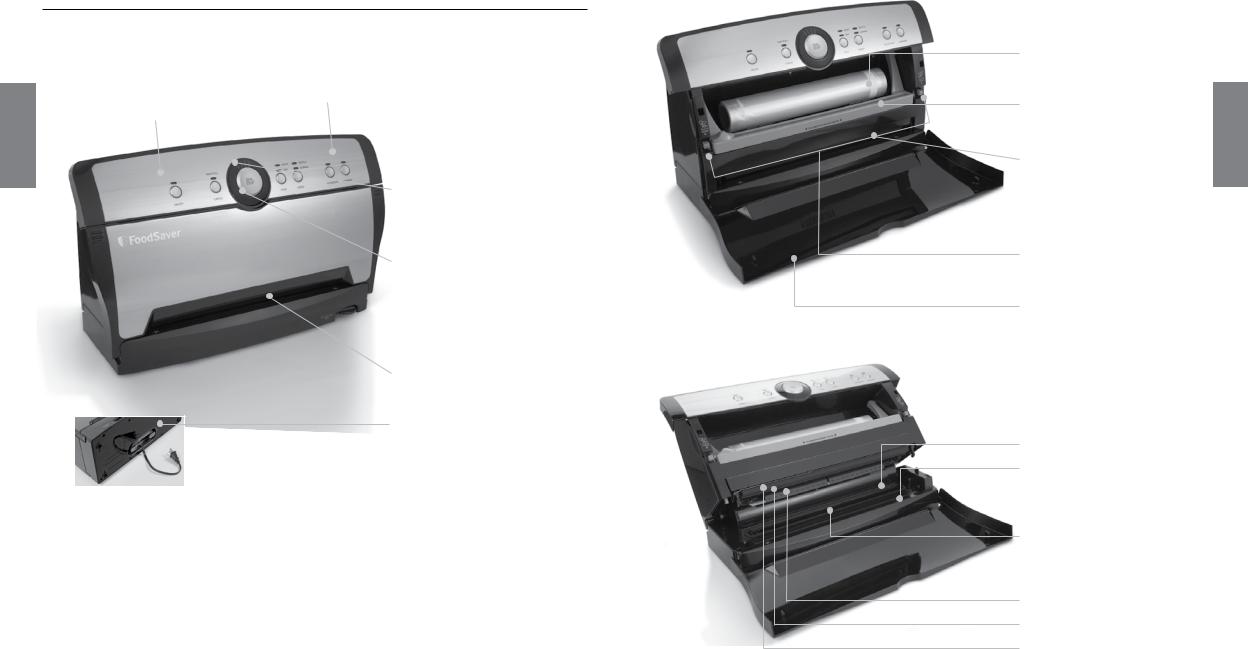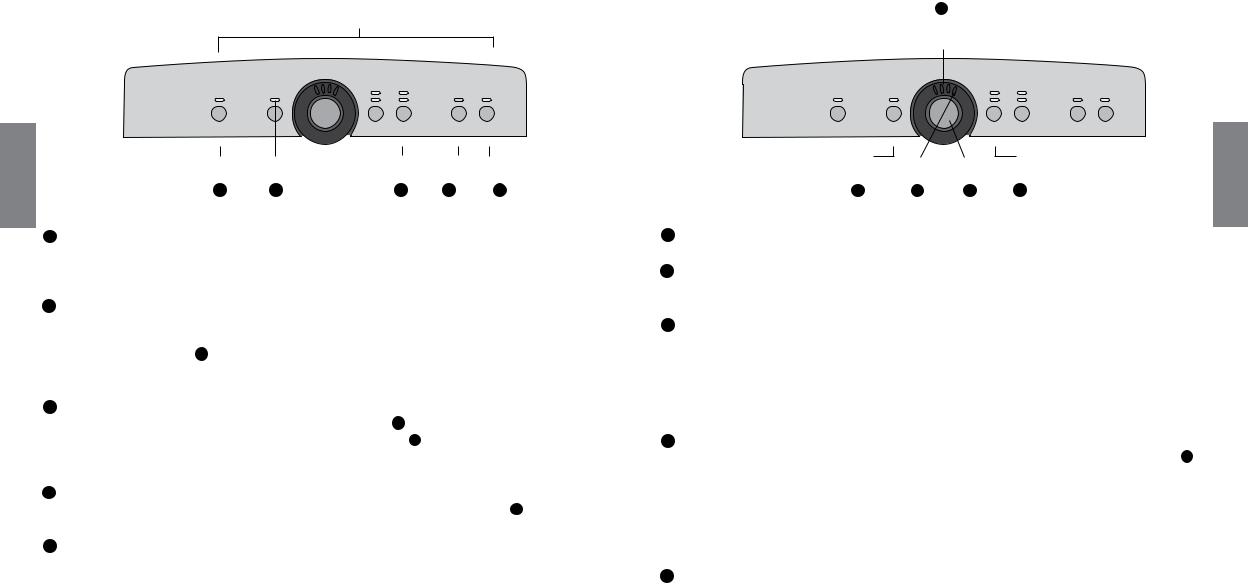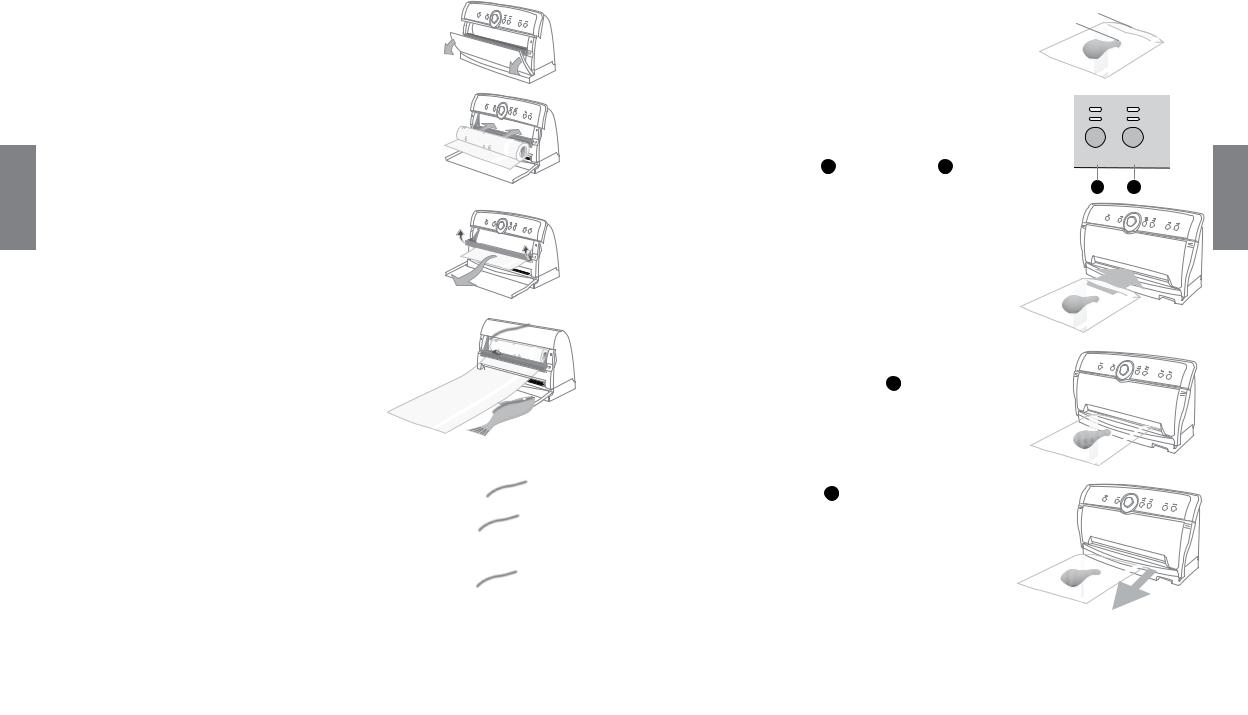FoodSaver V3820 User Manual

Registering your appliance is quick and easy at www.prodregister.com/foodsaver. If you register on our website, you will have the opportunity to receive special bag and accessory introductory offers. Refer to the registration card inside the box.
For important safety information and helpful tips, please visit us at www.foodsaver.com
(in English only) to get tips on vacuum sealing and order FoodSaver® brand accessories, bags and rolls, or call 1-877-777-8042 (U.S.), 1-877-804-5383 (Canada).
Enregistrer votre appareil est rapide et facile au www.prodregister.com/foodsaver. Quand vous utilisez notre site Web pour le faire, vous êtes admissible à certaines offres de lancement de sacs et d’accessoires. Voyez la carte d’enregistrement incluse dans l’emballage.
Pour obtenir d’autres renseignements de sécurité importants, des conseils pratiques relatifs à l’emballage sous vide, ainsi que pour commander des accessoires, sacs et rouleaux de marque FoodSaverMD , visitez au www.foodsaver.com (site uniquement offert en anglais) ou bien appelez le 1-877-777-8042 aux États-Unis, mais le 1 877 804-5383 au Canada.
©2011 Sunbeam Products, Inc. doing business as Jarden Consumer Solutions. All rights reserved. Distributed by Sunbeam |
User Manual & Recipe Book |
||
for V3820 series appliances |
|||
Products, Inc. doing business as Jarden Consumer Solutions, 20B Hereford St., Brampton ON Canada L6Y 0M1 |
|||
GSC-NM0311-2652911 |
|
||
|
Notice d’emploi et recettes |
||
©2011 Sunbeam Products, Inc. faisant affaires sous le nom de Jarden Consumer Solutions. Tous droits réservés. |
|||
Distribué par Sunbeam Products, Inc. faisant affaires sous le nom de Jarden Consumer Solutions, 20B Hereford St., |
pour appareils de la série V3820 |
||
Brampton (Ontario) Canada L6Y 0M1 |
|
||
|
|
||
Printed in China./Imprimé en Chine. |
P.N. 149580 |
www.foodsaver.com 1 877 804-5383 |
|
|
|
|
|

Table of Contents |
|
Important Safeguards and Tips................................................................................................. |
1 |
Welcome to FoodSaver® Vacuum Sealing System...................................................................... |
2 |
Features of Your FoodSaver® Appliance................................................................................... |
3 |
Removing Air from a Bag......................................................................................................... |
7 |
FoodSaver® Vacuum Sealing Accessories................................................................................ |
8 |
How to Make a Bag from a FoodSaver® Vacuum Sealing Roll................................................... |
9 |
How to Vacuum Seal with FoodSaver® Vacuum Sealing Bags.................................................. |
10 |
Guidelines for Vacuum Packaging.......................................................................................... |
11 |
Storage Guide - Meat, Cheese, Vegetables, Fruits.................................................................. |
13 |
Storage Guide - Baked Goods, Coffee, Snacks and Liquids...................................................... |
14 |
Care and Cleaning.................................................................................................................. |
15 |
Marinating with your FoodSaver® Appliance........................................................................... |
16 |
Recipes for your FoodSaver® Appliance.................................................................................. |
17 |
Trouble-Shooting................................................................................................................... |
21 |
Warranty.............................................................................................................................. |
22 |
Important Safeguards & Tips |
|
Important Safeguards
For your own safety, always follow these basic precautions when using a FoodSaver® appliance:
1.Read the User Manual carefully for operating instructions. Read all instructions in this manual before use.
2.Do not use appliance on wet or hot surfaces, or near a heat source.
3.To protect against electric shock, do not immerse any part of appliance, power cord or plug in water or other liquid. Unplug from outlet when not in use and before cleaning.
4.To disconnect, unplug power cord from electrical outlet. Do not disconnect by pulling on cord.
5.Do not operate appliance with a damaged power cord or plug. Do not operate appliance if it malfunctions or is in any way damaged. For details, contact Consumer Services at number listed below.
6.Use appliance only for its intended use.
7.Closely supervise children when using any electrical appliance. Do not allow appliance to be used as a toy.
8.120v Appliances Only: The FoodSaver® appliance has a polarized plug (one blade is wider than the other). To reduce risk of electrical shock, this plug is intended to fit in a polarized outlet only one way. If plug does not fit fully in the outlet, reverse plug. If it still does not fit, contact a qualified electrician. Do not modify plug in any way.
9.Caution: A short power cord is provided to reduce risks from entanglement or tripping over a longer cord. An extension cord may be used when marked electrical rating is no less than electrical rating of this appliance. All cords should not drape over counter or tabletop where cords can be tripped over or pulled on unintentionally, especially by children.
EN-1 |
www.foodsaver.com 1-877-804-5383 |
Important Safeguards & Tips continued
10.Do not place on or near a hot gas or electric burner, or heated oven. Extreme caution must be used when moving products containing hot liquids.
11.Wait 20 seconds between seals to allow appliance to cool.
For Household Use Only
SAVE THESE INSTRUCTIONS
Important Tips
1.Vacuum packaging is NOT a substitute for the heat process of canning. Perishables still need to be refrigerated or frozen.
2.For best results, use only with FoodSaver® Bags, Containers and Accessories.
3.During the vacuum packaging process, small amounts of liquids, crumbs or food particles can be inadvertently pulled into the Vacuum Channel. Empty the Drip Tray after each use.
4.Avoid overfilling, always leave at least 4 inches (10.16 centimeters) of bag material between bag contents and top of bag. This allows room for the bag material to cinch tightly against the food and prevents the bag from pulling out of the vacuum channel during the sealing process. Then leave at least one additional inch of bag material for each time you plan to reuse bag.
5.Do not create your own side seams for a FoodSaver® Bag. These bags are manufactured with a special side seam, which is sealed all the way to the outer edge.
6.To prevent wrinkles in the seal when vacuum packaging bulky items, gently stretch bag flat while inserting bag into vacuum channel and continue to hold bag until vacuum pump starts.
7.When you are vacuum packaging items with sharp edges (dry spaghetti, silverware, etc.), protect bag from punctures by wrapping item in soft cushioning material, such as a paper towel. You may want to use a canister or Mason jar instead of a bag.
8.When using accessories, remember to leave one inch of space at top of canister or container.
9.Pre-freeze fruits and blanch vegetables before vacuum packaging for best results. See “Guidelines for Vacuum Packaging” section.
This appliance has a polarized plug (one blade is wider than the other). As a safety feature, this plug will fit in a polarized outlet only one way. If the plug does not fit fully in the outlet, reverse the plug. If it still does not fit, contact a qualified electrician. Do not attempt to defeat this safety feature.
Welcome to FoodSaver® Vacuum Sealing System
Congratulations…
You are about to enjoy the freshness benefits of FoodSaver®, The #1 Selling Brand of Vacuum Packaging Systems. For years, the FoodSaver® Vacuum Packaging System has helped millions of households keep food fresh longer in the refrigerator, freezer and pantry. The FoodSaver® system is designed to remove air and extend freshness up to five times longer than conventional storage
methods. Keep your FoodSaver® appliance on your countertop, and you’ll soon discover its convenience and versatility.
Free Gift with Registration!
Register now and you’ll receive a free gift. It’s our “thanks” to you for being a FoodSaver® customer.
Register online at www.foodsaver.com/register. You’ll have access to special sale items for online registrants only!
Questions?
Contact customer service at 877-804-5383
or visit www.foodsaver.com.
Do not return this product to place of purchase.
www.foodsaver.com 1-877-804-5383 |
EN-2 |
welcome

Features of Your FoodSaver® Appliance
uresatF 
 A. Controls and Indicator Lights
A. Controls and Indicator Lights
Indicate current setting and vacuum progress for added control.
B. Vacuum Progress Display
Green lights signal progression of vacuuming and sealing process. All lights extinguish when the full process is finished.
C. Seal/Stop Button
CrushFree™ Instant Seal feature. Stops vacuum cycle and seals to prevent crushing delicate items.
 D. Retractable Accessory Hose/
D. Retractable Accessory Hose/
Accessory Port
Accessory hose can be used with all FoodSaver® Brand Accessories.
E. Vacuum Channel
Simply insert bag and the FoodSaver® appliance does the rest.
F. Power Cord Storage
At bottom of unit.
G.Built-in Roll Holder
For storage of FoodSaver® Vacuum Sealing Rolls.
H.Roll Cutter Bar
Simplifies making custom-sized bags.
I.Auto Bag Sensing
Simply insert open end of bag into the vacuum channel and the machine will sense and grasp the bag, vacuum, seal and shut-off automatically.
J.Release Buttons
To open appliance for cleaning.
K.Appliance Door
Opens to access Built-in Roll Holder and Cutter.
L.Lower Gasket (not removable)
M.Extra-wide Sealing Strip with Non-stick Coating
Provides extra secure, air-tight seal that’s two times wider.
N.Drip Tray
Catches overflow liquids and contains Food Sensors to detect liquid.
O.Upper Bag Detection Tray
P.Upper Foam Gasket (not removable)
Q.Rubber Seal Profile
Features
EN-3 |
www.foodsaver.com 1-877-804-5383 |
www.foodsaver.com 1-877-804-5383 |
EN-4 |

Indicator
LEDs
TRAY FULL |
MOIST |
GENTLE |
|
|
|
|
DRY |
NORMAL |
|
|
|
SEAL |
|
|
|
|
|
|
STOP |
|
|
|
|
ON/OFF |
CANCEL |
FOOD |
SPEED |
ACCESSORY |
MARINATE |
uresatF |
Power |
Tray Full |
|
Speed |
Accessory |
Marinate |
|
Button |
Indicator |
|
Settings |
Mode |
Mode |
|
1 |
2 |
|
3 |
4 |
5 |
1Power Button
Press the power button to begin. The Power Indicator, Speed Indicator and Food Indicator lights will become illuminated. After Vacuum Sealing, press Power Button to turn appliance Off. Note: After 12 minutes, the appliance will turn Off automatically.
2Tray Full indicator light
During the vacuum sealing process, small amounts of liquids, crumbs or food particles can be inadvertently pulled into the Drip Tray (N). When excess liquid fills the Drip Tray, the unit will turn off
and the Tray Full Indicator 2 will activate. To resume normal operation, remove the Drip Tray, empty liquid, wash in warm soapy water or place in top rack of dishwasher. Dry and place Drip Tray back into appliance. (See “Care and Cleaning” on page 15.)
3 SPEED SETTINGS BUTTON |
|
When vacuum sealing delicate items, press Speed Setting Button 3 |
so that the gentle speed indicator |
light is illuminated. For more control you may press Seal/Stop Button |
8 at any time to stop vacuum and |
begin automatic sealing process. Note: Appliance will default to Normal speed upon pressing the Power On Button or when power has been interrupted.
4ACCESSORY MODE Button
Press to achieve best vacuum for canisters and accessories. Push Accessory Mode Button 4 to begin vacuum process. Motor will run until Vacuum Sealing Process is complete.
5Marinate MODE Button
A ten minute predetermined sequence of vacuum pulse to rest ratio allowing foods to get optimum flavor infusion in the least amount of time. (See “Marinating with your FoodSaver® Appliance” section on page 16.)
10
Vacuum Progress Display
TRAY FULL |
MOIST |
GENTLE |
|
|
|
|
DRY |
NORMAL |
|
|
SEAL |
|
|
|
|
|
STOP |
|
|
|
ON/OFF |
CANCEL |
FOOD |
SPEED |
ACCESSORY |
MARINATE |
Cancel |
Seal |
Seal/Stop |
Adjustable |
Button |
Indicator Light |
Button |
Food Settings |
6 |
7 |
8 |
9 |
6Cancel Button
Immediately halts the current function and opens the Vacuum Channel.
7Seal Indicator Light
Constant Red light indicates sealing process is engaged. (Flashing light indicates error. See “Trouble-
Shooting” Section on page 21 for more information.)
8SEAL/STOP BUTTON
CrushFree™ Instant Seal feature-
This button has three uses:
1.Press to immediately stop the vacuum process and begin sealing the bag. This prevents crushing delicate items such as bread, cookies and pastries.
2.Press to create a seal when making bags from a FoodSaver® Roll.
3.Press to create a seal on Mylar bags (such as a potato chip bag) to keep food sealed air-tight.
9adjustable FOOD SETTINGS BUTTON
For optimal vacuuming and sealing of moist or juicy foods, press the Adjustable Food Setting Button 9 until the Moist Indicator Light is illuminated. Choose the dry food setting for foods without liquid.
The Moist Food Indicator light will flash when Food Sealing Sensors automatically detect any moisture or liquid in the drip tray (N).
Note: Appliance will default to Dry setting upon pressing the Power Button or when power has been interrupted, unless liquid is detected in the Drip Tray. (See “Care and Cleaning” section of this User Manual on page 15.)
10Vacuum Progress display
Displays vacuum levels as the bag or canister is evacuated.
Features
EN-5 |
www.foodsaver.com 1-877-804-5383 |
www.foodsaver.com 1-877-804-5383 |
EN-6 |

Removing Air from a Bag
uresatF
Avoid wrinkles when inserting the bag into the Vacuum Channel (E).
Wrinkles in seal may cause leakage and allow air to return into bag. To eliminate any wrinkles while inserting bag, curl down into the Vacuum Channel (E), hold bag with two hands gently stretching bag flat until vacuum pump begins. If you find wrinkles after sealing bag, simply cut bag open and vacuum seal again.
If motor runs for more than 30 seconds without stopping, consider the following:
If you are vacuum sealing with a bag, make sure the bag is properly sealed. (See “How to Make a Bag From a Roll” on page 9.) Check foam gasket around Upper Bag Detection Tray (O) to make sure it is free from food material. Do not attempt to remove gasket.
If vacuum sealing with an accessory, check Accessory Hose connections to ensure a tight fit.
Note: Appliance should be used in vertical orientation and not laid on its back. Note: Appliance will time out after a couple of minutes if vacuum cannot be reached.
FoodSaver® Vacuum Sealing Accessories
Accessory Hose Reel
1.Prepare container according to FoodSaver® Accessory Guidelines, which are included with accessory purchases.
2.Pull Accessory Hose (D) from appliance and insert the end into the port on accessory. Twist tab while inserting to ensure a tight fit.
3.Push Accessory Mode Button 4 to begin vacuum process. Motor will run until vacuum process is complete. (To Marinate, follow instructions found in Marinate Button section of this Guide on page 16.)
4.When motor turns off, gently twist and remove Accessory Hose from accessory.
Note: If you are using a canister with large white knob, rotate knob clockwise to the “Closed” position, then gently twist and remove Accessory Hose from accessory.
5.To test vacuum, simply tug on accessory lid. It should not move.
6.To retract accessory hose, while holding unit, gently pull on hose end to allow hose to retract into appliance. Do not release freely as it may damage the hose tip.
Important: When pulling hose Do Not extend beyond green circle marked on hose.
F
Features
EN-7 |
www.foodsaver.com 1-877-804-5383 |
www.foodsaver.com 1-877-804-5383 |
EN-8 |

How to |
How to |
|
Make a Bag from a FoodSaver® Vacuum Sealing Roll |
Vacuum Seal with FoodSaver® Vacuum Sealing Bags |
|
|
|
|
1.Open appliance door (Fig. 1) and place roll into Roll Holder (F) (Fig. 2).
For Best results, insert roll with material flap down. Note: Bags can be sealed with appliance door either open or closed.
howto
2.Lift up Roll Cutter Bar (H) and place bag material beneath the cutter bar (Fig. 3).
3.Pull out enough bag material to hold item being vacuum sealed, plus 4 inches (10.16 centimeters). Lower the Roll Cutter Bar and slide Bag Cutter (H) across the Cutter Bar (Fig. 4).
4. Press Seal/Stop Button (C). Red Seal Indicator Light 7 will illuminate (Fig. 5).
5.Using two hands, insert open end of bag, curl down, into Vacuum Channel (E) until clamp motor starts. Bag must be centered between arrows. (Vacuum Channel can operate with door opened or closed.)
6.When red Seal Indicator Light 7 turns off, sealing is complete. You may remove bag from the Vacuum Channel (E).
7.You now have one sealed end (Fig. 6).
8.Now you are ready to vacuum seal with your new bag (see next page).
Fig. 1
|
Flap |
From |
|
Fig. 2 |
|
Bottom |
|
|
|
||
|
|
|
1.Begin with a FoodSaver® Vacuum Sealing System Bag (or create a bag as described in the “How to Make a Bag from a Roll” section on page 9).
2.Place item(s) in bag, allowing at least 4 inches (10.16cm) of space between bag contents and top of bag (Fig. 1). The
extra space is required to allow the bag to seal tightly around contents.
3.OPTIONAL: If you wish to customize the vacuum sealing process you may select Food setting 9 and Speed Setting 3 (Fig. 2). Default setting is Normal Speed and Dry Food.
See page 5 and 6 for more information.
Fig. 1 |
|
|
|
|
4inches |
OPEN |
|
||
|
|
END |
||
|
|
|
|
|
SEALED |
END |
|
|
|
|
|
|
|
|
|
|
MOIST |
|
GENTLE |
|
|
DRY |
|
NORMAL |
Fig. 2 |
|
|
|
|
|
FOOD |
|
SPEED |
|
9 3
Fig. 3
H
Fig. 4
4.Your new FoodSaver® System Automatically Vacuums and Seals.
To Vacuum: DO NOT PRESS THE STOP/SEAL BUTTON. Using two hands, insert open end of bag, curl down, into Vacuum Channel (E) (Fig. 3/4).
Fig. 3 |
|
|
|
Insert Bag |
|
|
|
Curl Downward |
|
|
|
|
|
OPEN |
END |
SEALED |
|
|
|
END |
|
AUTOMATICALLY |
|
|
|
||
|
|
SEALS! |
|
|
|
|
Do Not Press Button! |
cm) |
4” |
 Food
Food
C
Fig. 5
OPEN |
END |
|
OPEN |
END |
|
Fig. 6 |
|
SEALED |
|
|
|
END |
|
|
|
|
|
|
OPEN |
END |
|
|
|
|
5.Continue to hold bag until vacuum pump starts. You may now release bag. The Vacuum Progress lights 10 will illuminate. Note: To prevent crushing delicate items, you may now press Seal/Stop Button (C) at any time to begin automatic sealing process.
6.When red Seal Indicator Light 7 turns off, remove bag (Fig. 5). Refrigerate or freeze if needed.
Note: Wait at least 20 seconds between seals to allow appliance to properly cool.
See www.foodsaver.com for additional hints, tips, instructional videos and information about how to purchase FoodSaver® parts and accessories like the Pre-cut Bag Storage.
Fig. 4
SEALED |
END |
|
Fig. 5
|
SEALED |
END |
|
|
|
SEALED |
END |
|
|
|
how to
EN-9 |
www.foodsaver.com 1-877-804-5383 |
www.foodsaver.com 1-877-804-5383 |
EN-10 |

ing kagc vacuum
Guidelines
for Vacuum Packaging
Vacuum Packaging and Food Safety
The vacuum packaging process extends the life of foods by removing most of the air from the sealed container, thereby reducing oxidation, which affects nutritional value, flavor and overall quality. Removing air can also inhibit growth of microorganisms, which can cause problems under certain conditions:
Mold – Easily identified by its fuzzy characteristic. Mold cannot grow in a low oxygen environment, therefore vacuum packaging can slow the growth of mold.
Yeast – Results in fermentation, which can be identified by smell and taste. Yeast needs water, sugar and a moderate temperature to grow. It can also survive with or without air. Slowing the growth of yeast requires refrigeration, while freezing stops it completely.
Bacteria – Results in an unpleasant odor, discoloration and/or soft or slimy texture. Under the right conditions, anaerobic bacteria such as Clostridium botulinum (the organism that causes Botulism) can grow without air and sometimes cannot be detected by smell or taste. Although it is extremely rare, it can be very dangerous.
To preserve foods safely, it is critical that you maintain low temperatures. You can significantly reduce the growth of microorganisms at temperatures of 40°F (4°C) or below. Freezing at 0°F (-17°C) does not kill microorganisms, but stops them from growing. For long-term storage, always freeze perishable foods that have been vacuum packaged, and keep refrigerated after thawing.
It is important to note that vacuum packaging is NOT a substitute for canning and it cannot reverse the deterioration of foods. It can only slow down the changes in quality. It is difficult to predict how long foods will retain their top-quality flavor, appearance or texture because it depends on age and condition of the food on the day it was vacuumed packaged.
IMPORTANT: Vacuum packaging is NOT a substitute
for refrigeration or freezing. Any perishable foods that require refrigeration must still be refrigerated or frozen after vacuum packaging.
Food Preparation and Reheating Tips
Thawing and Reheating Vacuum Packaged Foods
Always thaw foods in either refrigerator or
microwave — do not thaw perishable foods at room temperature.
To reheat foods in a microwave in a FoodSaver® Bag, always cut corner of the bag before placing it on a microwave-safe dish. However, to avoid hot spots, do not reheat bone-in meat or greasy foods
in microwave within a FoodSaver® Bag. You can also reheat foods in FoodSaver® Bags by placing them in water at a low simmer below 170°F (75°C).
Preparation Guidelines for Meat and Fish:
For best results, pre-freeze meat and fish for 1-2 hours before vacuum packaging in a FoodSaver® Bag. This helps retain the juice and shape, and guarantees a better seal.
If it’s not possible to pre-freeze, place a folded paper towel between meat or fish and top of bag, but below seal area. Leave paper towel in bag to absorb excess moisture and juices during vacuum packaging process.
Note: Beef may appear darker after vacuum packaging due to the removal of oxygen. This is not an indication of spoilage.
Preparation Guidelines for Hard Cheeses:
To keep cheese fresh, vacuum package it after each use. Make your FoodSaver® Bag extra long, allowing one inch of bag material for each time you plan to open and reseal in addition to the 4-inch room you normally leave between contents and seal. Simply cut sealed edge and remove cheese. When you’re ready to repackage the cheese, just drop it in bag and reseal.
IMPORTANT: Due to the risk of anaerobic bacteria, Soft cheeses should never be vacuum packaged.
Preparation Guidelines for Vegetables: Vegetables need to be blanched before vacuum packaging. This process stops the enzyme action that could lead to loss of flavor, color and texture.
To blanch vegetables, place them in boiling water or in the microwave until they are cooked, but still crisp. Blanching times range from 1 to 2 minutes for leafy greens and peas; 3 to 4 minutes for snap peas,
sliced zucchini or broccoli; 5 minutes for carrots; and 7 to 11 minutes for corn on the cob. After blanching, immerse vegetables in cold water to stop the cooking process. Finally, dry vegetables on a towel before vacuum packaging.
Note: All vegetables (including broccoli, brussels sprouts, cabbage, cauliflower, kale, turnips) naturally emit gases during storage. Therefore, after blanching, they must be stored in freezer only.
When freezing vegetables, it is best to pre-freeze them for 1-2 hours or until solidly frozen. To freeze vegetables in individual servings, first place on
a baking sheet and spread them out so they are not touching. This prevents them from freezing together in a block. Once they are frozen, remove from baking sheet and vacuum package vegetables in a FoodSaver® Bag. After they have been vacuum packaged, return them to the freezer.
IMPORTANT: Due to the risk of anaerobic bacteria, Fresh mushrooms, onions, & garlic should never be vacuum packaged.
Preparation Guidelines for Leafy Vegetables:
For best results, use a canister to store leafy vegetables. First wash the vegetables, and then dry with a towel or salad spinner. After they are dried, put them in a canister and vacuum package. Store in refrigerator.
Preparation Guidelines for Fruits:
When freezing soft fruits or berries, it is best to pre-freeze them for 1-2 hours or until solidly frozen. To freeze fruit in individual servings, first place on a baking sheet and spread them out so they are not touching. This prevents them from freezing together
in a block. Once they are frozen, remove from baking sheet and vacuum package fruit in a FoodSaver® Bag. After they have been vacuum packaged, return them to the freezer.
You can vacuum package portions for baking, or in your favorite combinations for easy fruit salad all year round. If storing in the refrigerator, we recommend using a FoodSaver® Canister.
Preparation Guidelines for Baked Goods:
To vacuum package soft or airy baked goods, we recommend using a FoodSaver® Canister so they will hold their shape. If using a bag, pre-freeze for 1-2 hours or until solidly frozen. To save time, make cookie dough, pie shells, whole pies, or mix dry ingredients in advance and vacuum package for later use.
Preparation Guidelines for Coffee and Powdery Foods:
To prevent food particles from being drawn into vacuum pump, place a coffee filter or paper towel at top of bag or canister before vacuum packaging. You can also place the food in its original bag inside a FoodSaver® Bag, or use a FoodSaver® Universal Lid with the original container to vacuum package.
Preparation Guidelines for Liquids:
Before you vacuum package liquids such as soup stock, pre-freeze in a casserole dish, loaf pan or ice cube tray until solid. Remove frozen liquid from pan and vacuum package in a FoodSaver® Bag. You can stack these “frozen bricks” in your freezer. When you’re ready to use, just cut corner of bag and place in a dish in microwave or drop into water at a low simmer, below 170°F (75°C).
To vacuum package non-carbonated bottled liquids, you can use a FoodSaver® Bottle Stopper with the original container. Remember to leave at least one inch of room between contents and bottom of Bottle Stopper. You can re-seal bottles after each use.
Preparation Guidelines for Make-ahead Meals, Leftovers and Sandwiches:
Efficiently store your make-ahead meals, leftovers and sandwiches in the stackable, lightweight FoodSaver® containers. They are microwaveable, top rack dishwasher safe and come with a custom adaptor. The lightweight containers will be ready to head off to the office or school when you are!
Preparation Guidelines for Snack Foods:
Your snack foods will maintain their freshness longer when you vacuum package them. For best results, use a FoodSaver® Canister for crushable items like crackers.
Vacuum Packaging Non-Food Items
The FoodSaver® vacuum packaging system also protects non-food items from oxidation, corrosion and moisture. Simply follow the directions to vacuum package items using FoodSaver® Bags, Canisters and Accessories.
To vacuum package silver, wrap fork tines in soft cushioning material, such as a paper towel, to avoid puncturing bag. Your FoodSaver® Bags are ideal for outdoor excursions. For camping and hiking, keep your matches, maps and food dry and compact. To have fresh water for drinking, simply fill a FoodSaver® Bag with ice, seal it and when needed, let the ice pack melt. If you’re going sailing or boating, vacuum package your food, film and
a dry change of clothes. Just remember to bring scissors or a knife to open the bag.
To keep emergency kits safe and dry, vacuum package flares, batteries, flashlights, matches, candles and other necessities. Your emergency items will stay dry and organized in your home, car or boat.
vacuum packaging
EN-11 |
www.foodsaver.com 1-877-804-5383 |
www.foodsaver.com 1-877-804-5383 |
EN-12 |

Storage Guide
Meat, Cheese, Vegetables, Fruits
|
|
|
|
Recommended |
|
|
|
|
|
Where |
FoodSaver® |
Storage Life |
Normal |
|
|
Foods |
to Store |
Bag/Accessory |
with FoodSaver® |
Storage Life |
|
|
Meat |
|
|
|
|
|
|
|
|
|
|
|
|
|
Beef, Pork, Lamb |
Freezer |
FoodSaver® Bag |
2-3 years |
6 months |
|
|
Ground Meat |
Freezer |
FoodSaver® Bag |
1 year |
4 months |
|
|
Poultry |
Freezer |
FoodSaver® Bag |
2-3 years |
6 months |
|
|
Fish |
Freezer |
FoodSaver® Bag |
2 years |
6 months |
|
|
Hard Cheeses ( Do not vacuum package soft cheese ) |
|
|
||
|
|
|
|
|
|
|
|
|
Cheddar, Swiss |
Refrigerator |
FoodSaver Bag, |
4-8 months |
1-2 weeks |
|
|
|
|
Canister |
|
|
|
|
|
|
|
|
|
|
|
Parmesan |
Refrigerator |
FoodSaver® Bag, |
4-8 months |
1-2 weeks |
|
|
|
|
Canister |
|
|
|
|
|
|
|
||
|
|
Vegetables ( Do not vacuum package fresh mushrooms, onions & garlic ) |
|
|||
|
|
|
|
|
|
|
|
|
Asparagus |
Freezer |
FoodSaver® Bag |
2-3 years |
8 months |
|
|
Broccoli, Cauliflower |
Freezer |
FoodSaver® Bag |
2-3 years |
8 months |
|
|
Cabbage, Brussels |
Freezer |
FoodSaver® Bag |
2-3 years |
8 months |
|
|
Sprouts |
|
|
|
|
|
|
|
|
|
|
|
|
|
Corn (cob or kernel) |
Freezer |
FoodSaver® Bag |
2-3 years |
8 months |
|
|
Green Beans |
Freezer |
FoodSaver® Bag |
2-3 years |
8 months |
|
|
Lettuce, Spinach |
Refrigerator |
FoodSaver® Canister |
2 weeks |
3-6 days |
|
|
Snow Peas, Snap Peas |
Freezer |
FoodSaver® Bag |
2-3 years |
8 months |
storag |
|
|||||
|
Fruits |
|
|
|
|
|
|
|
|
|
|
|
|
|
Apricots, Plums |
Freezer |
FoodSaver® Bag |
1-3 years |
6-12 months |
|
eg |
|
Peaches, Nectarines |
Freezer |
FoodSaver® Bag |
1-3 years |
6-12 months |
|
Softer Berries |
|
|
|
|
|
uide |
|
|
|
|
|
|
|
|
|
|
|
|
|
|
Raspberries, |
Refrigerator |
FoodSaver® Canister |
1 week |
1-3 days |
|
|
Blackberries |
|
|
|
|
|
|
|
Strawberries |
Refrigerator |
FoodSaver® Canister |
1 week |
1-3 days |
|
|
|||||
|
|
Harder Berries |
|
|
|
|
|
|
|
|
|
|
|
|
|
Blueberries |
Refrigerator |
FoodSaver® Canister |
2 weeks |
3-6 days |
|
|
Cranberries |
Refrigerator |
FoodSaver® Canister |
2 weeks |
3-6 days |
|
|
Huckleberries |
Refrigerator |
FoodSaver® Canister |
2 weeks |
3-6 days |
Baked Goods, Coffee, Snacks and Liquids
|
|
|
Recommended |
Storage |
|
|
|
Where |
FoodSaver® |
Life with |
Normal |
Foods |
to Store |
Bag/Accessory |
FoodSaver® |
Storage Life |
|
Baked Goods |
|
|
|
|
|
|
|
|
|
|
|
Bagels, Bread, |
Freezer |
FoodSaver® Bag |
1-3 years |
6-12 months |
|
Pastries |
|
|
|
|
|
|
|
|
|
|
|
Nuts |
|
|
|
|
|
|
|
|
|
|
|
Almonds, |
Pantry |
FoodSaver® Bag, Canister |
2 years |
6 months |
|
Peanuts |
|
|
|
|
|
|
|
|
|
|
|
Sunflower |
Pantry |
FoodSaver® Bag, Canister |
2 years |
6 months |
|
Seeds |
|
|
|
|
|
|
|
|
|
|
|
Coffee |
|
|
|
|
|
|
|
|
|
|
|
Coffee Beans |
Freezer |
FoodSaver® Bag |
2-3 years |
6 months |
|
Coffee Beans |
Pantry |
FoodSaver® Bag, Canister |
1 year |
3 months |
|
Ground Coffee |
Freezer |
FoodSaver® Bag |
2 years |
6 months |
|
Ground Coffee |
Pantry |
FoodSaver® Bag, Canister |
5-6 months |
1 month |
|
Prepared Liquids |
|
|
|
||
|
|
|
|
|
|
Sauces, Soups, |
Freezer |
FoodSaver® Bag |
1-2 years |
3-6 months |
|
Stews |
|
|
|
|
|
|
|
|
|
|
|
Bottled Liquids |
|
|
|
|
|
|
|
|
|
|
|
Oils |
Pantry |
FoodSaver® Bottle Stopper |
1-1 ½ years |
5-6 months |
|
Dry Foods |
|
|
|
|
|
|
|
|
|
|
|
Beans, Grains |
Pantry |
FoodSaver® Bag, Canister |
1-2 years |
6 months |
|
Pasta, Rice |
Pantry |
FoodSaver® Bag, Canister |
1-2 years |
6 months |
|
Powdery Foods |
|
|
|
|
|
|
|
|
|
|
|
Dry Milk |
Pantry |
FoodSaver® Bag, Canister |
1-2 years |
6 months |
|
Dried Coconut |
Pantry |
FoodSaver® Bag, Canister |
1-2 years |
6 months |
|
Flour |
Pantry |
FoodSaver® Bag, Canister |
1-2 years |
6 months |
|
Sugar, Brown |
Pantry |
FoodSaver® Bag, Canister |
1-2 years |
6 months |
|
Sugar |
|
|
|
|
|
|
|
|
|
|
|
Snack Foods |
|
|
|
|
|
|
|
|
|
|
|
Chips |
Pantry |
FoodSaver® Canister |
3-6 weeks |
1-2 weeks |
|
Cookies, |
Pantry |
FoodSaver® Canister |
3-6 weeks |
1-2 weeks |
|
Crackers |
|
|
|
|
|
|
|
|
|
|
|
storage guide
EN-13 |
www.foodsaver.com 1-877-804-5383 |
www.foodsaver.com 1-877-804-5383 |
EN-14 |
